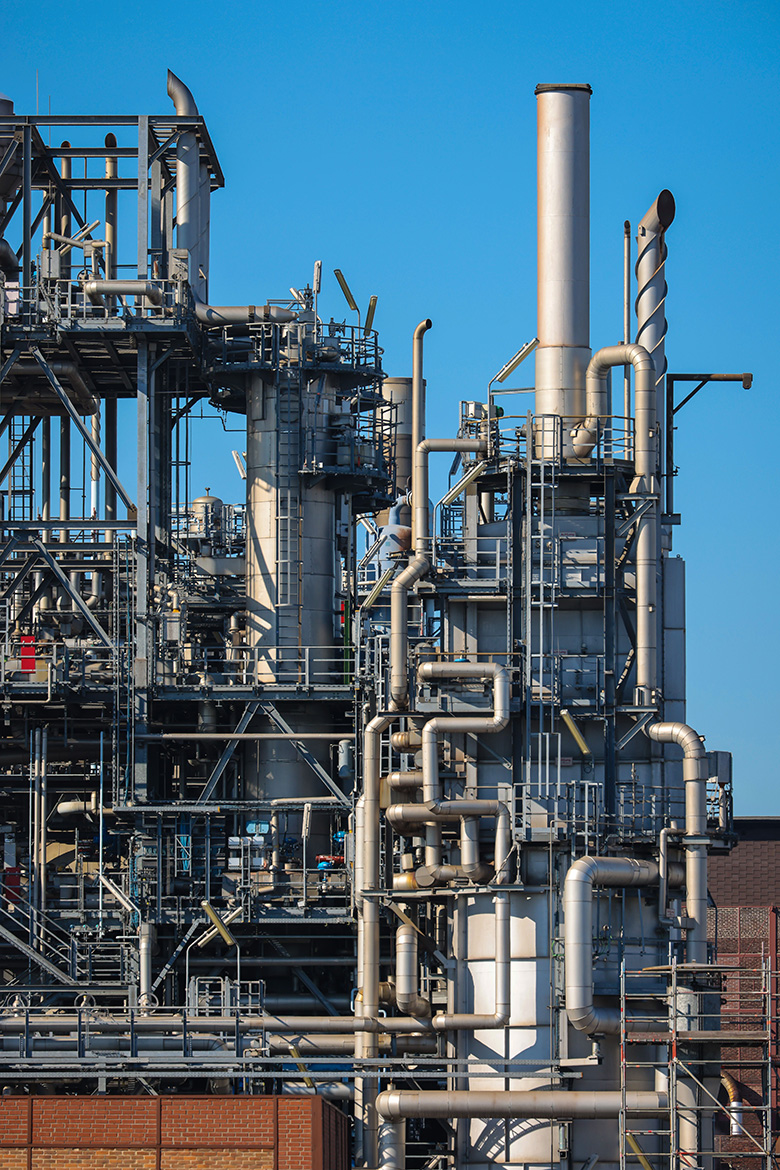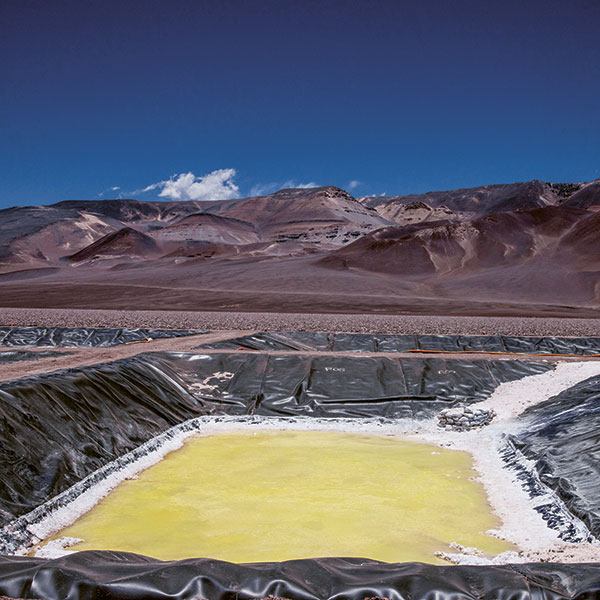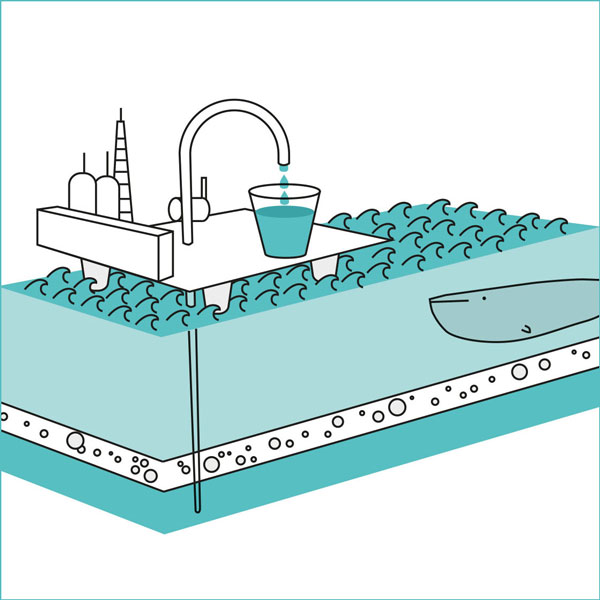ENERGY
Hydrogen: the energy of the future?
The goal of carbon neutrality has stirred fresh interest in hydrogen, a resource that can be extracted from natural gas, water and even from the ground in a more or less clean way.

In Oberhausen in Germany, so-called grey hydrogen is produced from fossil fuels in the conventional way. However, this also results in other products. | Image: Rupert Oberhäuser / Keystone
The idea of a future where energy comes from hydrogen may seem like it’s ripped from science fiction, futurology or the Soviet gas exploration. The novelist Jules Verne and the economist Jeremy Rifkin both dreamed there would be a never-ending source of it from breaking down water. Ukrainian and Russian researchers thought there would be an abundance in the ground under the USSR. Throughout this time, far from these ideas of potentially low carbon footprints, industry was betting on the growing amounts of hydrogen being obtained from fossil fuels, using that to produce fertilisers and refine oil.
So why the renewed interest? “The wave of interest began when we realised it would be hard to reach the goal of “zero net greenhouse gas emissions by 2050”, which was being adopted by a growing number of groups, without hydrogen playing a key role”, says Christian Bauer, a researcher at the Laboratory for Energy System Analysis at the Paul Scherrer Institute. Strict climate policies have actually opened up major horizons for low-carbon hydrogen. “This is why investments are multiplying, with a view to future use particularly in the metals and chemicals industries, as well as in sea and air transport”. But, for as much as hydrogen is attractive – for an equal mass, it holds 2-3 times more energy than natural gas and crude oil, leaving only water as a biproduct – it also has its disadvantages: the challenges of storage and transport, and the difficulty of obtaining it in a green way.
It seems the simplest way, given that it can piggyback an existing sector, is to ‘clean’ the production of hydrogen sourced from fossil fuels using carbon dioxide capture and storage techniques. This is often termed ‘blue’ hydrogen, as opposed to hydrogen obtained from fossil fuels without decarbonisation, which is termed ‘grey’. Is the transition from grey to blue possible, reliable and economically viable? “It depends. The media don’t like this response, which they often receive from scientists, but is particularly true in this case”, says Bauer.
In 2022, he published an overview of this topic together with European and North American researchers in which they concluded that climate neutral production is possible, but not yet achieved. To do so would require a drastic cut in the loss of natural gas used to produce hydrogen. These losses have been brought down to less than half a percent in some countries, e.g., Norway and Netherlands, but they remain above two percent in exporting countries like Russia and Libya. Above all, we need to develop methods that capture all of the CO2 emitted during production. This “is technically achievable, while slightly reducing the energy efficiency and increasing the costs, but it has yet to be demonstrated on a large scale”.
Technological leap through electrolysis
On first appearance, the most ecological path is obtaining ‘green’ hydrogen, which is extracted from water using electricity from renewable sources. But can we? “We’ve been electrolysing water for two centuries, but on the large scale there have been issues up until very recently. Lately, the production systems have made a technological leap that now lets us imagine this as an achievable scenario”, says Pasquale Cavaliere, an engineering researcher at the University of Salento, Italy.
Going beyond the ‘classical’ electrolysis in an alkaline solution, the use of a polymer electrolyte membrane, developed in the 1950s by NASA, has undergone accelerated progress. “This system uses less and lasts longer, thereby allowing a cost reduction. But getting the necessary investment to finish this technological leap requires major collaboration among industry, research and politics”, he says.
For the moment, green hydrogen remains 2-3 times more expensive than its blue counterpart (which costs 2-3 times more than the grey kind). Its main advantage is that it can be converted into a storable energy source extracted from intermittent or seasonal sources (solar, hydro), meaning flexibility for these electricity sectors. Other avenues are being explored. In 2023, a team at EPFL’s Laboratory for Molecular Engineering of Optoelectronic Nanomaterials presented a device that uses solar energy to convert water vapour in the air into hydrogen.
The surprise may come from ‘native’ or ‘natural’ hydrogen, known as ‘white’ in the colour scheme, which comes from underground. “Before reading the first article on this 3-4 years ago, I didn’t know it existed”, says Christian Bauer.
“The early birds on this path are often seen as crazy. I know one who was put off to the point that they changed profession and started teaching yoga”, says the geochemist Eric C. Gaucher, who left his post at the University of Bern in May 2023 to dedicate his work to the company Lavoisier H2 Geoconsult, which works on research, prospection and consulting in natural hydrogen.
When Gaucher came across white hydrogen, he was working at Total. “We were wondering whether mantle rock under the oil basins would play a role in the chemistry of these basins. We know that they produced hydrogen when in contact with water – that’s the serpentinisation reaction – and we wondered where the hydrogen went. We led a field mission to the Pyrenees along a fault relating to a major tectonic boundary, and bingo! From day one, the gasometer found hydrogen”, he says.
The surprise in the crust
Gaucher then began studying the way in which hydrogen was formed in the Earth’s crust. There were three tectonic processes involved. The first occurs when the crust breaks, an ocean forms and the mantle comes into contact with sea water. The second occurs when one plate slides under another, undergoing a change that produces water, which reacts with the mantle of the plate above it. In the third, pieces of mantle are pushed upwards when a mountain range is created and become exposed to rainwater. In every phase, the production of hydrogen is potentially happening.
“What’s missing is the understanding of the migration of hydrogen in the subsoil at the assessment of reserves, for which the methods are still in their infancy”, says Gaucher. All we can do is to drill, at least where mining laws allow it. “We’ve gone from research to industry where there is palpable excitement, and a community is forming”. Drilling is underway in the USA, anticipated in Australia and planned in Brazil.
What about Switzerland? “Signs show that hydrogen flows through the tectonic faults in the Alps. We need to see where it’s stocked”, says Gaucher. Prospecting has taken place in Val de Hérens (Valais), “but we’ve only found the traces of a fossil system that produced hydrogen in the past, rather than an active system like in the Pyrenees”.
Is that a let-down? “In oil, with 200 years of technology and billions in investment, the success rate is one well in ten. There’s no reason to be demotivated”. Knowing that to date, less than 0.7 percent of the world’s production of hydrogen is ‘green’ or ‘blue’, and that a quantitative leap in these sectors will take at least two decades according to the optimistic scenarios, the quest for hydrogen under our feet seems, for now at least, to make sense.




